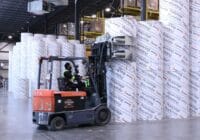Running a warehouse isn’t just about storing boxes. It’s about optimizing space, minimizing waste, and ensuring safety — all while keeping operations efficient. That’s where 5S comes in.
At Trebley, we believe in combining practical systems with smart, flexible logistics. Whether you use our warehousing, inventory management, or kitting services, the 5S methodology can level up how your operation runs.
What is 5S?
5S is a foundational tool in lean warehousing. Originally from Japan, it’s a five-step approach to keeping the workplace organized, efficient, and safe.
Each “S” stands for a Japanese term:
| Japanese | English | Description |
| Seiri | Sort | Remove unnecessary items from the warehouse. Only keep what adds value. |
| Seiton | Set in Order | Arrange tools and materials logically. A place for everything. |
| Seiso | Shine | Clean regularly to identify problems early and maintain safety. |
| Seiketsu | Standardize | Create repeatable processes and visual standards. |
| Shitsuke | Sustain | Train teams to maintain 5S and continuously improve. |
Let’s break down how each of these applies in a warehouse setting.
1. Sort: Eliminate What You Don’t Need
The first step in the 5S methodology is to get rid of anything that doesn’t add value. This means clearing out expired products, broken pallets, unused tools, excess packaging, and anything else taking up unnecessary space.
By regularly sorting and auditing your warehouse inventory, you reduce clutter, improve safety, and free up room for fast-moving and essential items. This process also helps prevent inventory inaccuracies, streamlines workflow, and creates a cleaner, more organized environment for your team.
2. Set in Order: Organize with Logic
After removing clutter, the next step is to arrange everything so it’s easy to find, use, and return. Group similar items together, label shelves and bins clearly, and use floor markings to define zones for storage, packing, and shipping. Implementing systems like FIFO (First-In, First-Out) ensures older stock moves out first, reducing waste.
Logical organization speeds up pick-and-pack processes, reduces search time, and minimizes errors—helping your team work faster and more efficiently.
3. Shine: Keep the Warehouse Clean
Cleaning isn’t just for appearances—it’s essential for safety, efficiency, and equipment longevity. Dust, spills, or debris can hide damage or create hazards that slow down operations or lead to accidents. Incorporating regular cleaning routines, including floor sweeping, shelf wiping, and equipment checks, helps identify issues early and maintain a professional work environment.
A clean warehouse also improves visibility, reduces the risk of product contamination, and fosters a culture of responsibility among staff
4. Standardize: Make It Routine
Standardization turns good practices into daily habits. This involves creating clear, repeatable procedures for tasks like sorting, cleaning, and organizing. Use visual SOPs (standard operating procedures), shadow boards for tools, consistent labeling systems, and shift checklists to guide teams.
When processes are standardized, tasks become more predictable and efficient—even when dealing with different products or rotating staff. It also ensures quality control, reduces training time for new employees, and keeps the entire operation running smoothly across shifts.
5. Sustain: Train, Audit, Improve
The most challenging part of 5S is making it stick. Sustaining means embedding the system into the company culture through ongoing staff training, regular audits, and strong leadership support. It’s about building habits—not one-time efforts. Continuous improvement is key: track performance, document processes, gather feedback, and refine as needed.
When everyone—from the floor team to management—is committed to the system, 5S becomes part of daily operations, leading to long-term efficiency, safety, and reliability.
Key Benefits of 5S in Warehousing
- Improved Safety: Clear walkways and proper storage reduce accidents.
- Higher Productivity: Workers spend less time searching and more time fulfilling orders.
- Better Inventory Accuracy: Fewer misplaced or lost items means smoother stock handling.
- Space Optimization: You get the most out of every square foot of storage.
- Employee Morale: Clean and well-structured spaces reduce stress and confusion.
Also Read: Benefits of Warehousing
Real-World Warehouse Examples
Here’s how each step might look inside a modern warehouse like Trebley’s:
- Sort: Dispose of expired goods, unused materials, or packaging waste.
- Set in Order: Use color-coded bins, label inventory zones, apply barcodes.
- Shine: Daily sweeping, equipment cleaning, and spill response protocols.
- Standardize: Implement routine checklists, rack labels, and 5S signage.
- Sustain: Conduct monthly 5S audits and involve teams in continuous improvement.
Best Practices for 5S Success
- Engage Everyone: Don’t just train managers—get warehouse floor teams involved.
- Use Visuals: Floor tape, signs, and color codes speed up training and recognition.
- Track Progress: Use scorecards and internal KPIs to track cleanliness and order accuracy.
- Align with Kaizen: Pair 5S with continuous improvement methods to stay ahead of operational issues.
- Connect to KPIs: Link 5S progress to real outcomes like picking speed or error reduction.
Bonus: Safety — The Unofficial 6th “S”
While not originally part of 5S, safety is a natural byproduct of a lean, clean warehouse. But it also deserves its own spotlight:
- Use anti-slip tape, reflective markings, and proper PPE.
- Mark forklift zones, pedestrian lanes, and hazardous areas.
- Train staff to spot safety hazards during cleaning.
5S Audit Checklist (Quick Reference)
Use this checklist to track your progress:
Sort
- Are unused or obsolete items removed?
- Are walkways and work areas clutter-free?
Set in Order
- Are all tools and SKUs labeled and stored in proper locations?
- Are heavy and frequently used items accessible?
Shine
- Are machines clean and operational?
- Are floors free of liquids, debris, and empty packaging?
Standardize
- Are SOPs visible and followed?
- Are visual cues (floor tape, charts) updated?
Sustain
- Are 5S audits scheduled and recorded?
- Are staff trained and engaged?
Common 5S Challenges (and How to Solve Them)
1. Resistance to Change
Solution: Educate teams on time savings and safety gains. Involve them in planning and feedback.
2. Inconsistent Application
Solution: Use visual guides, assign responsibilities, and rotate audits.
3. Lack of Time
Solution: Start small — one zone at a time. Don’t wait for the “perfect time.”
4. Fading Momentum
Solution: Celebrate wins, track improvements, and tie results to KPIs.
How Trebley Supports Lean Warehousing

Trebley helps businesses across Canada and the U.S. grow faster through lean warehousing and logistics. Our 140,000 sq ft facility in Dartmouth is optimized using 5S and other lean practices to help customers:
- Store only what they need — with no long-term contracts
- Scale without worrying about capacity
- Improve order accuracy and space efficiency
- Rely on integrated services like kitting, labeling, and cross-docking
Whether you’re shipping locally or across borders, Trebley ensures that every step is fast, safe, and smart.
Why Trebley Uses 5S Principles
5S isn’t just a warehouse tactic — it’s a core part of how Trebley operates.
Our services include:
- Warehousing & Inventory Management: Only pay for space you actually use.
- Transportation: From local trucking to long-haul and rail logistics.
- Cross Docking: Faster turnaround with floor-to-pallet and pallet-to-floor handling.
- Kitting & Handling: Clean, accurate, and efficient assembly and prep.
Whether you’re a startup or a large enterprise, 5S helps us keep our promise:
Be Smart. Be Flexible. Be Free.
Final Thoughts
5S is more than a cleaning checklist. It’s a mindset shift. In warehousing, it means better safety, better output, and happier teams.
At Trebley, we live by principles like 5S to deliver real results. Because your business deserves a partner that’s organized, smart, and built for growth.
Ready to bring 5S-level efficiency to your supply chain?
Contact Trebley today and start growing your business with flexible, reliable warehousing and logistics services.
FAQs
1. What is 5S in warehousing?
5S in warehousing is a lean methodology focused on improving organization, safety, and efficiency through five steps: Sort, Set in Order, Shine, Standardize, and Sustain.
2. Why is 5S important in warehouse operations?
5S is important in warehouse operations because it reduces waste, minimizes errors, improves safety, and increases productivity by creating a clean and structured environment.
3. How does 5S improve warehouse safety?
5S improves warehouse safety by eliminating clutter, marking hazards, organizing tools, and ensuring regular cleaning—all of which help reduce workplace accidents.
4. What are the five steps of 5S in warehousing?
The five steps of 5S in warehousing are:
- Sort: Remove unnecessary items.
- Set in Order: Organize tools and materials.
- Shine: Keep the space clean.
- Standardize: Create routines and SOPs.
- Sustain: Maintain through audits and training.
5. How can I implement 5S in my warehouse?
To implement 5S in your warehouse, start small: clean a section, label shelves, train your staff, and build standard checklists. Track progress with regular audits and visual cues.
6. What are the benefits of using 5S in logistics?
Using 5S in logistics improves inventory accuracy, speeds up picking, boosts team morale, reduces storage costs, and helps maintain a safer, more efficient workflow.
7. How often should 5S audits be done in a warehouse?
5S audits should be done regularly—ideally monthly or quarterly—to maintain standards, track improvements, and identify areas that need retraining or adjustments.
8. Can 5S work in small warehouses or fulfillment centers?
Yes, 5S works well in small warehouses and fulfillment centers. Its scalable approach helps even small teams improve space utilization and order processing accuracy.





